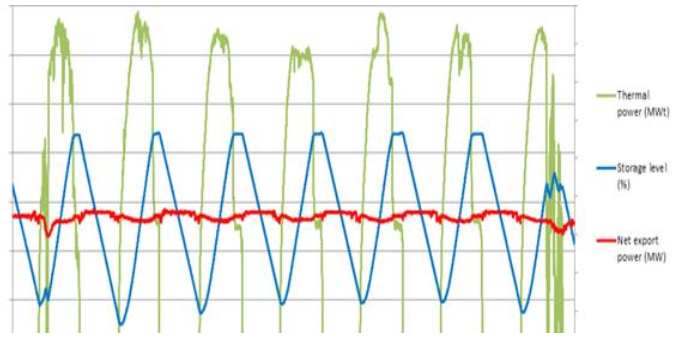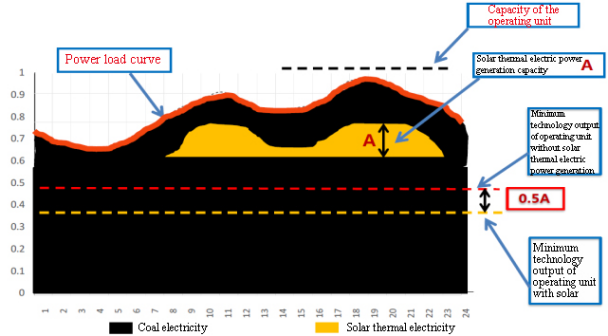At the 3rd China Solar Thermal Electricity Conference initiated by China National Solar Thermal Alliance, Mr. Sun Rui, Vice Director of the Electric Power Planning & Engineering Institute elaborated the role of solar thermal electricity generation (CSP) in China's energy transformation and its prospect. Mr. Sun’s speech is summaried as follows:
I. The Current Situation and Forecast of Electricity in China
In 2016, the total consumption of primary energy in China was 4.36 billion tons of standard coal and the proportion of non-fossil energy was 13.5%. The proportion of non-fossil energy in primary energy consumption is expected to reach 15% by 2020, 20% in 2030 and 50% in 2050.
In 2016, the total power generation capacity in China was 5.99 trillion kWh. In the composition of power generation capacity, the proportion of non-fossil energy power generation was about 29%; the total power installed capacity was 1.65 billion kW and the proportion of non-fossil energy power generation installed capacity was about 38%.
Based on the "Eleventh Five-Year" plan, in 2020, the proportion of non-fossil energy power generation will be over 31% and the proportion of non-fossil energy power generation installed capacity be about 39%.
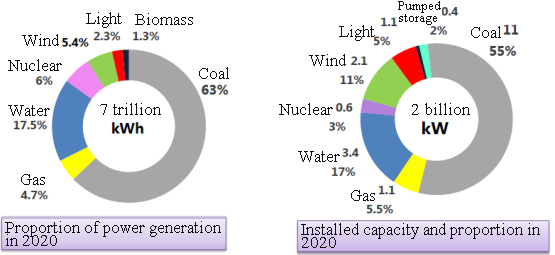
The National Development and Reform Commission and Energy Bureau released the Energy Production and Consumption Revolution Strategy (2016-2030) and proposed the non-fossil energy leapfrog development action. Based on it, by 2030, the proportion of non-fossil energy power generation to total power generation is expected to reach 50%. How to reach this target? The plan is still being made and no result is available. According to some sources, it is estimated that by 2030, the proportions of the power generation and installed capacity will be as follows (see the figure below); the solar power installed capacity is likely to reach 500 million kilowatts; the installed capacity of solar thermal electricity generation will take a large proportion; and the number electricity generation hour of solar thermal power plant will be over three times of that of solar PV. So the proportion of its power generation is likely to exceed the photovoltaic power generation.
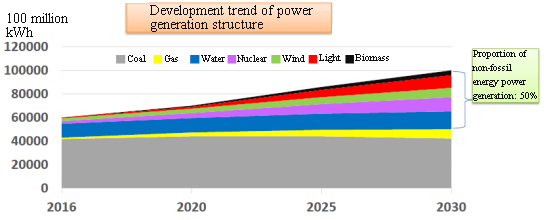
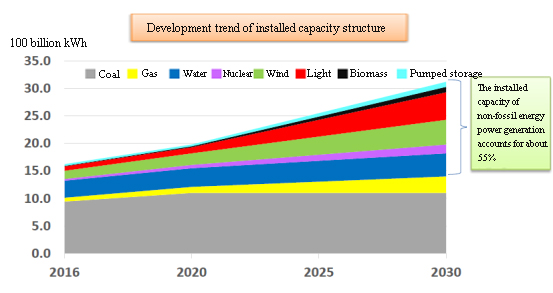
II. The role of solar thermal electricity generation in energy transformation
The solar thermal electricity generation can also be equipped with the heat storage system. So the solar thermal power plant is able to generate power steadily without sunshine, and the electricity output of can be adjusted according to the changes in power system load.
The following figure shows the output curves of the 19.9MW Gemasolar CSP power plant (with 15 hours of heat storage) in Spain at 0:00 pm on July 11, 2012 and during one week. It can be seen from the first figure that the plant can continue to generate electricity for 24 hours a day. The second figure shows the continuous power generation of the plant during one week; the output is very stable.
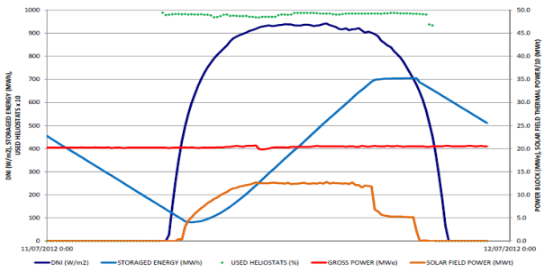
、
Figure: The output curve (upper one) of the 19.9MW Gemasolar solar power plant in Spain at 0:00 pm on July 11, 2012 and the output curve during one week (lower one)
From the CSP’s characteristics, compared with the coal-fired plantsplants, the solar thermal power plant has better regulation performance; the adjustment scope of sCSP plant can be from 20% to 100%; the allowable heating rate of steam generator is 10℃/min; and the turbine start-up time (hot state - cold state) takes only 20-60 minutes.
Figure: Schematic diagram of the operating characteristics of solar thermal plantspower plant (in spring and autumn)
The difference between the power generation in summer and in winter is relatively large in China. The above figure is the operational characteristics diagram of solar thermal plantspower plant in spring and in autumn. The power stations with heat storage of more than 10 hours are basically the same case as this. In spring and autumn, the sunlight is enough to generate the rated power after sunrise; in noon, the output can be slightly lowered, which is conductive to reducing the abandoned light of photovoltaic power generation in the power grid. In summer, the solar thermal plantspower plant can continuously generate power for 24 hours; and in winter, it is basically to store heat in daytime and to generate power during the peak period in the evening.
In summary, through the configuration of the thermal storage system, the solar thermal plantspower plant can maintain the stable power output, without being impacted by the changes in solar intensity; if the capacity of the thermal storage system is large enough, the plant can achieve 24 hours continuous power generation; meanwhile, it can rapidly adjust the output of the turbine generator according to the needs of the power grid load rapidly, namely participating in the primary frequency modulation and secondary frequency modulation of power grid; in addition, comparing with the coal-fired plantplants, the solar plantsthermal power plant has the shorter start and stop time, the lowest operating load and better peaking performance.
Therefore, I think that the solar thermal plantspower plant can play two major roles in China’s power system:
1)to bear the basic load as the main power source in the power system;
2)to bear the peak load as the peaking power source in the power system.
It must be emphasized that as the peaking power source, the principle is that it is not at the expense of the economy of solar thermal plantspower plant. For example, the sunlight intensity id relatively high in summer, it is basically able to make continuous power generation for 24 hours; it the plant is made to operate at low load, there will abandon the light as the PV does, so that the economy of the plant is affected. Now, some owners and banks are worried about whether the solar thermal power plant also has the problem of abandoning sunlight. The full-amount grid connection of renewable energy power generation is protected by law; but why it is not applicable to wind power and photovoltaic power at present? Because there is a legal guarantee, but in the absence of configuration of the power plant and being affected by the weather conditions, the reliability of wind power and photovoltaic power supply cannot be guaranteed, and it is impossible to completely replace the coal-fired plantsplants. Therefore, solar photovoltaic power and wind power can only be served as the supplement to the electricity of power system, but cannot be served as the power protection for power system. In particular, during the late peak of the power load, the coal-fired plantsplants must be kept operating. If the wind power is supplied, the output of coal-fired plants will be reduced. At present, the minimum output of the coal-fired plants is 50%. Therefore, in the system that the wind power and photovoltaic power generation account for a relatively large proportion, the space for accepting wind power and photovoltaic power is limited. As the solar thermal power plants are equipped with the thermal storage system, its power supply reliability is guaranteed; and there is no need for coal-fired plants to provide power protection. Therefore, under the condition that the full-amount grid connection of solar thermal plants is protected by law, it is able to realize the reliability of power supply technically. Solar thermal electric power generation is a kind of renewable energy power generation; meanwhile, because of its regulation role, it can make power system accept wind power and photovoltaic power generation. This is because that the solar thermal electric power generation plants have replaced the coal-fired plants, reducing the minimum technical output of operating plants in power grid. Therefore, its contribution to improving the proportion of renewable energy power generation capacity is 1.5 times of that the solar thermal electric power generation plants!
III. The development prospects of solar thermal electricity generation in China
According to the primary estimation, the land with DNI>1700kWh/m2 in China is about 940,000 km2; and such lands are basically the Gobi and desert. The annual electricity generation of 100,000 square kilometers is expected to be 54000×108kWh. If calculation is made on the basis of 4000 usable hours of heat storage system, the installed capacity of the 100,000 square kilometers of land is about 1.35 billion kilowatts.
At present, all places are actively making planning for solar thermal electric power generation. For example, as for the "Yumen Huahai million-kilowatt solar thermal electric power generation base in Gansu", the planning period is from 2016 to 2030 and the total installed capacity is 5.6 GW, including the first phase (from 2016 to 2020) of 2.05GW, the second phase (from 2021 to 2025) of 1.5GW and the third phase (from 2026 to 2030) of 2.05 GW. As for the "Alashan Left Banner solar thermal power generation demonstration base in Inner Mongolia", the planning period is from 2016 to 2030; the total installed capacity is 16GW; and in recent (2016 to 2020), the installed capacity is 3GW. The water accumulated in the flood season of the Yellow River can solve the water problem, because the land used is the desert. As for the "Middle and long term solar thermal electric power development planning of Hami in Xinjiang", the planning period is from 2016 to 2030 and the total planning installed capacity is adjusted to 20GW, in which, 1.5GW is planned to be constructed in 2020.
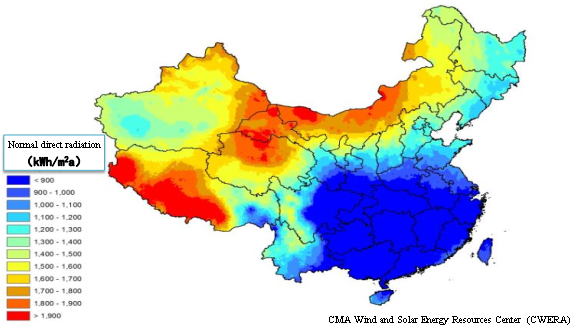
Figure: National direct solar radiation distribution map
Now, let's have a look at the power generation cost. Now, the first batch of domestic solar thermal power demonstration projects is started. According to the investment in engineering projects with relatively good solar resources in China, it is estimated that the unit investment of the engineering is about RMB 3000 yuan/kW and the on-grid price is ranging from RMB 1.15 to 1.25 yuan/kWh. In the compositions of electricity price, the proportions of investment cost and financing costs are the largest, accounting for about 60%. The actual cost of solar thermal power demonstration is basically RMB 25,000 yuan to RMB 30,000 yuan per kW; at that time, the electricity price declared was generally RMB 1.2 yuan/kWh, but at last, the electricity price approved by the NDRC is RMB 1.15 yuan/kWh; such price is not enough, so the National Development and Reform Commission emphasizes in the document approving the electricity price that the policy support in terms of land, tax and credit shall be granted to solar thermal power generation. However, according to the implementation of the first batch of projects, it is very difficult to implement such policy support; many difficulties have been encountered; some projects are stagnant, maybe because the expected return on investment has not been realized.
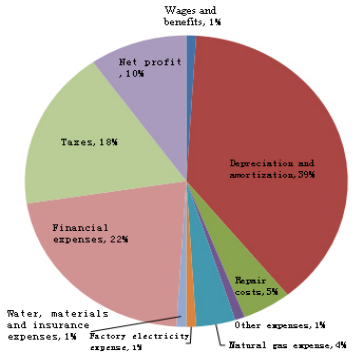
Figure: The composition of the on-grid price of certain domestic CSP project (Typical year)
Now, there is a gap between the solar thermal power generation costs in China and in international community, which cannot be simply compared. China's DNI level is lower than that of other countries and the solar resources are relatively poor. In some places of foreign countries, such as California in the United States, the annual DNI is more than 2600 kWh/m2, but the DNI in regions with good solar resource in China is just 1800-2000 kWh/m2, which means that the annual power generation of the same power station is 30-40% less. There is a very good news that the joint venture established by Shanghai Electric and the U.S. BrightSource obtained the bidding of 2 sets of 100MW CSP project in Dubai with the electricity price of 9.45 US cents/kWh. Such an electricity price level is because of the local good solar resource and the lower financing cost. The domestic authority predicts that by 2020, the engineering price of China's solar thermal power generation project will be reduced to lower than RMB 15,000 yuan /kW. By then, the on-grid electricity price will be reduced to less than RMB 0.75 yuan/kWh.
IV. Summary and related recommendations
Solar thermal power generation technology has been applied to the commercial power plants for over 30 years in the international community. Following the United States and Spain, Morocco, the Middle East and other regions are constructing power stations in large scale. After more than 10 years of research, we basically grasp the principles and characteristics of solar thermal power generation. The construction and operation experience accumulated during the construction and operation of the first commercial power station of Zhejiang SUPCON has laid foundation for our large-scale development of solar thermal power generation. According to the current solar resources and land resources of China, there is a very good prospect in the future.
The use of desert and Gobi in the western region to build large-scale solar thermal power generation bases can effectively improve the proportion of renewable energy power generation in China, which is conducive to the realization of China's energy substitution and carbon emission reduction strategic objectives. Vigorous development of solar thermal power generation can promote the process of western development, promote the development of China's solar thermal power industry, significantly promote the growth of the national economy, and meanwhile is conducive to domestic enterprises to participate in the competitions in the international market.
At last, there are some suggestions. First, it is suggested that the local government must do a good solar thermal power generation planning. The solar thermal power generation project has the features as complex system, large covering area, highly associating with external resources of plant site and relative concentration, etc.; therefore, regional development planning must be done. Only doing a good job in site development under the guidance of planning is able to quickly and orderly carry out construction of engineering project, and meanwhile will help to reduce the cost of power generation.
Second, it is suggested that the state shall grant low-interest loans policy to solar thermal electricity generation projects. China's lending rate is relatively high in the international community, which is about 2% in the international community but 4% in China. As the credit interest rate of domestic bank is relatively high, in the compositions of electricity price of solar thermal electricity generation projects, the proportion of financing costs is over 20%, which has increased the investment cost. We hope that domestic policy banks will be able to grant low-interest loans policy to solar thermal electricity generation projects, and also hope that the competent departments for domestic listing can support the World Bank and Asian Development Bank to grant low-interest loans to solar thermal electricity generation projects.
Third, it is suggested to start the second batch of demonstration projects. Some problems have been encountered by the first batch of solar thermal electricity generation projects; some are the common problems and some are individual problems. In accordance with the "Thirteen Five-year" power development plan, the 5GW installed capacity of solar thermal electricity generation shall be realized in 2020. However, the construction period of solar thermal electricity generation projects is relatively long; the construction and installation period is at least 24 months; and it is impossible to carry out construction and installation in winter in the northwest region. Therefore, the project construction period is about three years. A certain period of time is required from the project declaration to the final determination of the on-grid price. Now, the remaining time is already very urgent, thus it is suggested to start the declaration work of the second batch of solar thermal electricity generation projects timely. Before 2020, it is the process of laying foundation. Only by starting the engineering project and such a large-scale application can develop our industry and lower the cost. If no project to be constructed, it is difficult to improve the technology and it is also difficult to go to the international market.
At last, it is suggested to strengthen international exchanges and cooperation. After all, the international community has accumulated over 30 years of research and development, construction and operation experience in solar thermal electricity generation, learning from the international experience will help use to develop solar thermal electricity generation faster. Meanwhile, it is required to speed up the pace of independent R & D and engineering application of core technologies, so as to lay a solid foundation for solar thermal electricity generation industry to go to the international market.

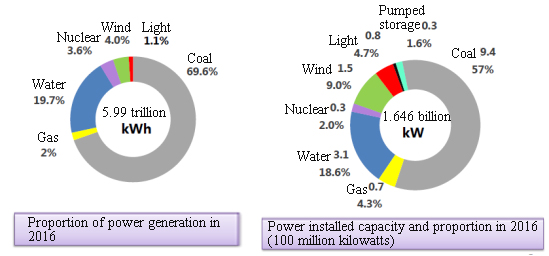



 、
、